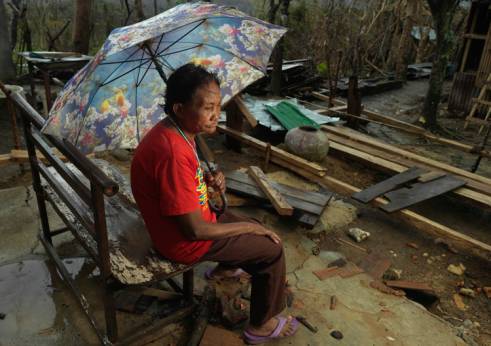By Attila Kulcsar
HelpAge’s analysis of the latest data from the Philippines suggests that almost two fifths of people killed by Typhoon Haiyan were over the age of 60 – despite the fact that this age group makes up only 8% of the general population in the worst affected areas.
As with previous natural disasters, the data suggests older people have been disproportionately affected. According to the latest information from the Philippines government’s National Disaster Risk Reduction and Management Council, the total number of dead is 5,759.
According to the latest information from the Philippines government’s National Disaster Risk Reduction and Management Council, the total number of dead is 5,759.
Out of the 381 fatalities whose ages were recorded, 147 people, or 39% were over 60 years of age.
Evidence of previous tsunami and storm disasters around the world also points to a disproportionate effect on older people. In Hurricane Katrina, 49% of those killed were over 75, while in the 2011 earthquake in Japan, 64% of those killed were over 60.
Older people face specific challenges
Mobility challenges and lack of assistance from families and communities in time of crisis mean older people are often disproportionately accounted for in the number of people killed. When older people do decide to flee, they face risks including the possibility of being separated from family and friends.
In the case of Typhoon Haiyan, many older people did not evacuate because they thought that their houses could withstand the storm, just as they had done for decades.
Older people living with their extended family are less vulnerable than those living alone both in terms of income security and personal safety. In the Philippines, data shows that older people living alone come from the most impoverished families, and are amongst the poorest in the country – approximately 80% of older men and women living alone in rural areas are considered poor, while 77% of older women and 56% of men living alone are widowed.
The combination of poverty and lack of family support makes these older people particularly vulnerable in crises and poses enormous challenges for meeting their basic needs.
The forgotten survivors
Francesca, 78, sits on a bench within what are now four imaginary walls where her house once stood. She stares pensively at the ruins, clutching her blue umbrella, one of the few treasured possessions that Typhoon Haiyan did not take from her. The typhoon turned the road to her village into nothing more than a mud track.
“It’s about 20 minutes up the hill but the very old and very young can’t come up and down it now, it’s too hard,” Francesca said.
“My house has been totally destroyed,“ she continues. “I can’t even get my clothes and cooking utensils out from under the rubble. Right now we are taking shelter in the health centre which has very little roof left.
“My husband is 85 and is ill and is lying on a bed there, but no medical staff have come back to work at the health centre. No one is coming to see us. Because he is old, I think the medical services think his case is not an emergency.”
Traumatised by the typhoon
Sadly, Francesca and her husband are not alone in their misery. Older people are often extremely vulnerable after disasters, especially those with disabilities, reduced mobility and poor health.
This can make queuing for water, food, medicine and shelter extremely difficult. Those who survive the disaster also seem to suffer from a different kind of trauma, as the feeling of loss is greatly amplified by decades of memories and emotional attachment over their destroyed property and livelihood.
Francesca’s problems do not end there: “I have diabetes and have run out of medicine. I don’t know where to go to get it, as I usually buy it from the hospital. If I don’t take the medicine I get bad pains in my legs and I find it hard to walk, and I will need a stick to get around.
“For now, I’m rubbing herbal plants on my legs but I need the medicine soon. Many of the children and older people here are now getting sick and are in need of help.”
HelpAge International is working with its local partner, Coalition of Services for the Elderly (COSE), on the ground to meet the needs of the most vulnerable older people. Local aid workers have used motorbikes to access the hardest to reach areas in order to establish people’s needs and ensure that older people get the support they need.
In its response to the emergency, COSE and HelpAge have distributed food aid to about 40,000 of the most vulnerable people.
Donate now
In the UK
Our sister organisation, Age International, has launched an emergency appeal to support older people affected by Typhoon Haiyan.
Or you can text URGENT to 70004 to donate £5 to help older people in the Philippines.
In the USA
Our sister organisation, HelpAge USA, has launched an emergency appeal to support older people affected by Typhoon Haiyan.
Elsewhere
If you live outside the UK and the USA you can donate to support older people affected by Typhoon Haiyan here.
